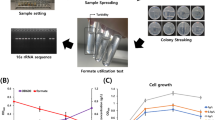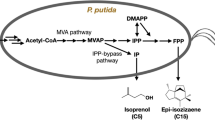Abstract
Pseudomonas putida was metabolically engineered to produce medium chain length polyhydroxyalkanoate (mcl-PHA) from acetate, a promising carbon source to achieve cost-effective microbial processes. As acetate is known to be harmful to cell growth, P. putida KT2440 was screened from three Pseudomonas strains (P. putida KT2440, P. putida NBRC14164, and P. aeruginosa PH1) as the host with the highest tolerance to 10 g/L of acetate in the medium. Subsequently, P. putida KT2440 was engineered by amplifying the acetate assimilation pathway, including overexpression of the acs (encoding acetyl-CoA synthetase) route and construction of the ackA-pta (encoding acetate kinase-phosphotransacetylase) pathway. The acs overexpressing P. putida KT2440 showed a remarkable increase of mcl-PHA titer (+ 92%), mcl-PHA yield (+ 50%), and cellular mcl-PHA content (+ 43%) compared with the wild-type P. putida KT2440, which indicated that acetate could be a potential substrate for biochemical production of mcl-PHA by engineered P. putida.




Similar content being viewed by others
References
Agnew DE, Pfleger BF (2013) Synthetic biology strategies for synthesizing polyhydroxyalkanoates from unrelated carbon sources. Chem Eng Sci 103:58–67
Belda E, Van Heck RGA, José Lopez-Sanchez M et al (2016) The revisited genome of Pseudomonas putida KT2440 enlightens its value as a robust metabolic chassis. Environ Microbiol 18(10):3403–3424
Bernal V, Castaño-Cerezo S, Cánovas M (2016) Acetate metabolism regulation in Escherichia coli: carbon overflow, pathogenicity, and beyond. Appl Microbiol Biotechnol 100(21):8985–9001
Blattner FR, Plunkett G, Bloch CA et al (1997) The complete genome sequence of Escherichia coli K-12. Science 277(5331):1453–1462
Borrero-de Acuña JM, Bielecka A, Häussler S et al (2014) Production of medium chain length polyhydroxyalkanoate in metabolic flux optimized Pseudomonas putida. Microb Cell Fact 13:88
Brandl H, Gross RA, Lenz RW, Fuller RC (1988) Pseudomonas oleovorans as a source of poly(beta-Hydroxyalkanoates) for potential applications as biodegradable polyesters. Appl Environ Microbiol 54(8):1977–1982
Cerrone F, Davis R, Kenny ST et al (2015) Use of a mannitol rich ensiled grass press juice (EGPJ) as a sole carbon source for polyhydroxyalkanoates (PHAs) production through high cell density cultivation. Bioresour Technol 191:45–52
Chen J, Li W, Zhang ZZ, Tang TW, Li ZJ (2018) Metabolic engineering of Escherichia coli for the synthesis of polyhydroxyalkanoates using acetate as a main carbon source. Microb Cell Fact 17(1):102
Chen Y, Cheng JJ, Creamer KS (2008) Inhibition of anaerobic digestion process: a review. Bioresour Technol 99(10):4044–4064
Chong H, Yeow J, Wang I, Song H, Jiang R (2013) Improving acetate tolerance of Escherichia coli by rewiring its global regulator cAMP receptor protein (CRP). PLoS ONE 8(2):e77422
Davis R, Duane G, Kenny ST, Cerrone F, Guzik MW, Babu RP, Casey E, O’Connor KE (2015) High cell density cultivation of Pseudomonas putida KT2440 using glucose without the need for oxygen enriched air supply. Biotechnol Bioeng 112(4):725–733
Davis R, Kataria R, Cerrone F, Woods T, Kenny S, O’Donovan A, Guzik M, Shaikh H, Duane G, Gupta VK (2013) Conversion of grass biomass into fermentable sugars and its utilization for medium chain length polyhydroxyalkanoate (mcl-PHA) production by Pseudomonas strains. Bioresour Technol 150(4):202–209
Escapa IF, Del Cerro C, Garcia JL, Prieto MA (2013) The role of GlpR repressor in Pseudomonas putida KT2440 growth and PHA production from glycerol. Environ Microbiol 15(1):93–110
Fernández-Sandoval MT, Huerta-Beristain G, Trujillo-Martinez B, Bustos P, González V, Bolivar F, Gosset G, Martinez A (2012) Laboratory metabolic evolution improves acetate tolerance and growth on acetate of ethanologenic Escherichia coli under non-aerated conditions in glucose-mineral medium. Appl Microbiol Biotechnol 96(5):1291–1300
Gillis J, Ko K, Ramsay JA, Ramsay BA (2018) Potential for mcl-PHA production from nonanoic and azelaic acids. Can J Microbiol 64:11–19
Guzik MW, Kenny ST, Duane GF et al (2014) Conversion of post consumer polyethylene to the biodegradable polymer polyhydroxyalkanoate. Appl Microbiol Biotechnol 98(9):4223–4232
Hu P, Chakraborty S, Kumar A, Woolston B, Liu H, Emerson D, Stephanopoulos G (2016) Integrated bioprocess for conversion of gaseous substrates to liquids. Proc Natl Acad Sci USA 113(14):3773
Kirkpatrick C, Maurer LM, Oyelakin NE, Yoncheva YN, Maurer R, Slonczewski JL (2001) Acetate and formate stress: opposite responses in the proteome of Escherichia coli. J Bacteriol 183(21):6466
Kovach ME, Elzer PH, Hill DS, Robertson GT, Farris MA, Roop RM, Peterson KM (1995) Four new derivatives of the broad-host-range cloning vector pBBR1MCS, carrying different antibiotic-resistance cassettes. Gene 166:175–176
Lee GN, Na J (2013) Future of microbial polyesters. Microb Cell Fact 12(1):1–4
Lee HM, Jeon BY, Oh MK (2016) Microbial production of ethanol from acetate by engineered Ralstonia eutropha. Biotechnol Bioprocess Eng 21(3):402–407
Lee SY (2015) Bacterial polyhydroxyalkanoates. Biotechnol Bioeng 49(1):1–14
Lemos PC, Serafim LS, Reis M (2004) Polyhydroxyalkanoates production by activated sludge in a SBR using acetate and propionate as carbon sources. Water Sci Technol 50(10):189–194
Livak KJ, Schmittgen TD (2001) Analysis of relative gene expression data using real-time quantitative PCR and the 2[-Delta Delta C(T)] method. Methods 25(4):402–408
Li Y, Huang B, Wu H, Li Z, Ye Q, Zhang YP (2016) Production of succinate from acetate by metabolically engineered Escherichia coli. ACS Synth Biol 5(11):1299
Li ZB, Loh XJ (2015) Water soluble polyhydroxyalkanoates: future materials for therapeutic applications. Chem Soc Rev 44(10):2865–2879
Magdouli S, Brar SK, Blais JF, Tyagi RD (2015) How to direct the fatty acid biosynthesis towards polyhydroxyalkanoates production? Biomass Bioenergy 74:268–279
Mozejko-Ciesielska J, Dabrowska D, Szalewska-Palasz A, Ciesielski S (2017) Medium-chain-length polyhydroxyalkanoates synthesis by Pseudomonas putida KT2440 relA/spoT mutant: bioprocess characterization and transcriptome analysis. AMB Express 7(1):92
Nelson KE, Weinel C, Paulsen IT, Dodson RJ, Hilbert H, Martins VDS, Fouts DE, Gill SR, Pop M, Holmes M (2002) Complete genome sequence and comparative analysis of the metabolically versatile Pseudomonas putida KT2440. Environ Microbiol 4(12):799–808
Ni C, Wu X, Jin D, Du D, Ni C, Wu X, Jin D, Du D (2014) Facile recovery of acetic acid from waste acids of electronic industry via a partial neutralization pretreatment (PNP)—distillation strategy. Sep Purif Technol 132:23–26
Oehmen A, Pinto FV, Silva V, Albuquerque MGE, Reis MAM (2014) The impact of pH control on the volumetric productivity of mixed culture PHA production from fermented molasses. Eng Life Sci 14(2):143–152
Poblete-Castro I, Binger D, Rodrigues A, Becker J, Dos Santos V, Wittmann C (2013) In-silico-driven metabolic engineering of Pseudomonas putida for enhanced production of poly-hydroxyalkanoates. Metab Eng 15(1):113–123
Rai R, Keshavarz T, Roether JA, Boccaccini AR, Roy I (2011) Medium chain length polyhydroxyalkanoates, promising new biomedical materials for the future. Mater Sci Eng R 72(3):29–47
Rajaraman E, Agarwal A, Crigler J, Seipeltthiemann R, Altman E, Eiteman MA (2017) Transcriptional analysis and adaptive evolution of Escherichia coli strains growing on acetate. Appl Microbiol Biotechnol 100(17):1–9
Sambrook J (2001) Molecular cloning: a laboratory manual. Anal Biochem 186(1):182–183
Shahid S, Mosrati R, Ledauphin J, Amiel C, Fontaine P, Gaillard JL, Corroler D (2013) Impact of carbon source and variable nitrogen conditions on bacterial biosynthesis of polyhydroxyalkanoates: evidence of an atypical metabolism in Bacillus megaterium DSM 509. J Biosci Bioeng 116(3):302–308
Sin MC, Tan IKP, Annuar MSM, Gan SN (2012) Thermal behavior and thermodegradation kinetics of poly(vinyl chloride) plasticized with polymeric and oligomeric medium-chain-length poly(3-hydroxyalkanoates). Polym Degrad Stab 97(11):2118–2127
Steinbüchel A, Füchtenbusch B (1998) Bacterial and other biological systems for polyester production. Trends Biotechnol 16(10):419
Switch TA (2005) The acetate switch. Mol Biol Rev 69(1):12–50
Valappil SP, Rai R, Bucke C, Roy I (2008) Polyhydroxyalkanoate biosynthesis in Bacillus cereus SPV under varied limiting conditions and an insight into the biosynthetic genes involved. J Appl Microbiol 104(6):1624–1635
Wang Q, Tappel RC, Nomura CT (2012) Development of a new strategy for production of medium-chain-length polyhydroxyalkanoates by recombinant Escherichia coli via inexpensive non-fatty acid feedstocks. Appl Environ Microbiol 78(2):519
Wang Y, Yin J, Chen GQ (2014) Polyhydroxyalkanoates, challenges and opportunities. Curr Opin Biotechnol 30(30):59–65
Xiao Y, Ruan Z, Liu Z, Wu SG, Varman AM, Liu Y, Tang YJ (2013) Engineering Escherichia coli to convert acetic acid to free fatty acids. Biochem Eng J 76(28):60–69
Acknowledgements
The authors are very grateful for the kind donation of E. coli MG1655 from Dr. Tao Chen and the plasmid pBBR1MCS-2 from Dr. Yingjin Yuan of Tianjin University (China). The authors wish to acknowledge the financial support provided by the National Basic Research Program of China (Grant No. 2014CB745100), the National Natural Science Foundation of China (Grant No. 21576197), Tianjin Research Program of Application Foundation and Advanced Technology (Grant No. 18JCYBJC23500), and Tianjin Key Research & Development Program (Grant No. 16YFXTSF00460). We thank LetPub (www.letpub.com) for its linguistic assistance during the preparation of this manuscript.
Author information
Authors and Affiliations
Corresponding author
Additional information
Publisher's Note
Springer Nature remains neutral with regard to jurisdictional claims in published maps and institutional affiliations.
Rights and permissions
About this article
Cite this article
Yang, S., Li, S. & Jia, X. Production of medium chain length polyhydroxyalkanoate from acetate by engineered Pseudomonas putida KT2440. J Ind Microbiol Biotechnol 46, 793–800 (2019). https://doi.org/10.1007/s10295-019-02159-5
Received:
Accepted:
Published:
Issue Date:
DOI: https://doi.org/10.1007/s10295-019-02159-5




